The Seasons of Death for Wild Horses
The Biden administration is Trump’s equal when it comes to persecuting the horse herds of the American West.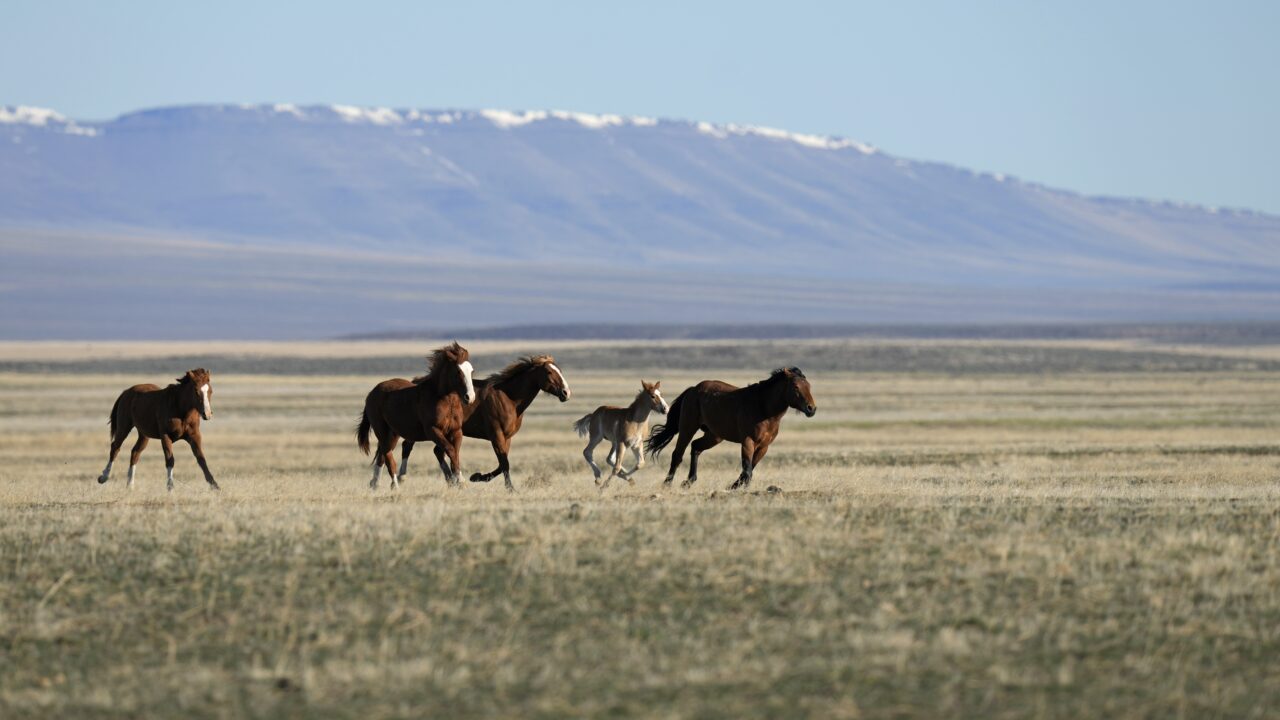 Wild horses gallop on the Fort McDermitt Paiute-Shoshone Indian Reservation on April 25, 2023, near McDermitt, Nevada. (Photo: AP/Rick Bowmer)
Wild horses gallop on the Fort McDermitt Paiute-Shoshone Indian Reservation on April 25, 2023, near McDermitt, Nevada. (Photo: AP/Rick Bowmer)
NEVADA — My friend Laura Leigh, wild horse advocate and troublemaker, stood on a dirt road in Nevada last July, in the raging heat of the high desert, and prepared herself for what she knew would be a summer of death. Wild horses, she told me, would perish under the watch of the Biden administration, just as they had under Trump. Throughout July and August, as the temperatures soared during a heat wave unprecedented in fury, there were cruel roundups conducted by the U.S. Bureau of Land Management, the agency tasked with protection of the iconic horses of the American West. The justification? The BLM claimed the animals had overpopulated their ranges and had to be removed with all due expediency. With brute force if necessary.
This was the turn for the worse under Biden that Leigh had expected. Other horse advocates had deludedly thought the Democratic administration would reform the BLM and bring a new era of humane handling of wild equids. After all, he had appointed a Native American, Deb Haaland, to head the Department of the Interior, which houses the BLM. For the Indigenous peoples of North America, the continuing survival of wild horse herds recalled the transformation of native lifeways that occurred with the adoption of horse culture.
But Haaland appeared to care little about wild horses. Instead, their fate had been sealed with a Trump-era policy called Path Forward, which Haaland adopted without hesitation. Path Forward was the brainchild of hard right Republican Rep. Chris Stewart, who has long represented the interests of the number one enemy of wild horses: cattlemen. Livestock interests consider horses to be cows’ competitors for forage and water on the West’s arid public rangelands.
The summer of death unfolded as expected, courtesy of a taxpayer-funded bureaucracy. During a heatwave at the Antelope Complex roundup, for example, nine wild horses died in four days.
A handout to the livestock industry, Path Forward ordered the BLM to massively expand roundups on federal herd management areas where the animals were alleged to have overpopulated. The cattlemen nodded in approval, as the fewer horses on public lands, the better for the fattening of their herds. After Congress fully funded Path Forward in 2020, Haaland’s BLM sprung into action, overseeing the largest increase in roundups of wild horses on record. Meanwhile, BLM’s second most important constituent, the mining industry, also got what it wanted. Gold, silver and molybdenum companies, who prefer landscapes free of wild animals, view horses as impediments to plunder.
As head of the nonprofit Wild Horse Education in Reno, Leigh had been conducting citizen oversight of wild horse policy for close to two decades. During that time, it didn’t seem to matter whether a Democratic or Republican administration roosted in Washington. The BLM had a remarkably consistent record on wild horses, one that stood outside partisan politics. The irony was not lost on Leigh that the appointment of Deb Haaland was supposed to represent a break from the past, and here was Haaland dedicating manpower and resources to maintain the violent status quo.
Now, on July 9, Leigh was parked on a dirt road in her cruddy SUV near a backcountry corral 20miles off U.S. 93, armed with a video camera at the onset of a heat wave, fearing she’d capture the usual footage of bloody abuses and outright destruction of the animals. Her view of the corral, however, was soon obstructed by large trucks that were moved in front of her vehicle at the order of BLM officials. Legal precedent — which Leigh had established under the First Amendment in a lawsuit in 2015 — said that citizens should have a reasonable chance of documenting for the public what actually goes on when the federal government handles horses. But the BLM wasn’t interested in the First Amendment. “The BLM doesn’t want us around,” Leigh told me, “because we represent the public interest.”
The summer of death unfolded as expected, courtesy of a taxpayer-funded bureaucracy. During a heatwave at the Antelope Complex roundup, for example, nine wild horses died in four days. There have been an estimated 50,000 horses captured so far under Biden, as he carries the ball for the Trump program. (The BLM does not keep readily available statistics on how many of those were killed or injured.) Leigh and her team of field observers have documented horses being whipped, choked with rope, tased with electric prods and rammed into barbed wire fences. Some of the animals got their legs or necks broken in the hysteria of the roundup and had to be shot. July is the start of foaling season, and thus, there were numerous foals — babies, we’d call them if they were human — who were chased to exhaustion and collapsed in the heat. They too had to be shot.
Roundups present a kind of Dantean hellscape, lurid scenes of masses of animal flesh racing to escape the ear-shattering noise of helicopters. The choppers, flying low, do most of the dirty work, driving the panicked herds in whirlwinds of dust toward waiting teams of wranglers, who issue whatever punishment is needed to reach the endgame: getting the terrified creatures into jerry-built corrals. Corralling is an archaic and savage process, as the horses are pushed into narrower and narrower passageways, or alleys, made of crude pipe-fence. The wranglers stand next to the alleys and shout and crack whips as the horses smash together, fighting and kicking and neighing, trying to flee. The wranglers prefer whips but on occasion will stick their “hot-shots” — electric prods — in the horses’ faces and shock them if they get out of hand. Sometimes they use the hot shots out of laziness, to speed up the awful work and get it done.
The horses are then sorted by sex and age. Equus caballus, a species that lives and dies by the solidarity of the family group, reacts the way humans react when families are broken apart. The mares and the stallions call out, over and over, looking for each other and for their foals. The band stallions, bunched together with lower-ranked bachelor males — who in the open range are hated rivals — descend into bloody melees. They attack the bachelors, biting and kicking, punching and grappling, with thudding blows. The noise crescendos as the foals, separated from both mother and father, whine and cry. At one trap this year, Leigh watched a crying foal pace along a fenceline trying to reach his mother on the other side. The mare maneuvered herself as close to the fence as she could to let the weakened creature nurse through the mesh of wire, as her udder swelled and “bagged up.” Just like in human beings, the sound of a baby horse crying triggers lactation.
They will be in prison, and what horses experience in prison is also not too different from the human experience: overcrowding, misery, infighting, disease, stress and inadequate food and drink.
Leigh has seen many such roundups. In recent years, with climate change, they have become increasingly painful to witness. In August of 2020, in the Blue Wing Complex northeast of Reno, wildfire smoke blowing in from California was so bad Leigh couldn’t see the helicopter pushing horses into the trap until the lights on the chopper flashed. The air quality index was in the zone of dark purple, as bad as it could get. Yet the BLM did not suspend roundups, regardless of the warnings that even domestic horses were not to be walked or exercised in conditions of such heavy smoke.
Once the animals are sorted, they are moved onto tractor trailers, which will carry them to long-term holding facilities where they are subject to conditions totally alien to their lifeways on the Nevada landscape. They will be in prison, and what horses experience in prison is also not too different from the human experience: overcrowding, misery, infighting, disease, stress and inadequate food and drink. In the holding facilities an untold number of wild horses have died. While the BLM will not release exact numbers, Leigh’s research suggests that between 2018 and 2022 there were some 6,000 deaths, many of which were due to epidemics of ringworm, pigeon fever, papillomavirus, equine influenza, streptococcus and salmonella that have swept through the populations in holding.
What Might We Do?- Support Wild Horse Education, an organization that works to protect wild horses and burros, preserve the wild places they call home and defend the laws they depend on for their survival.
- Support WildLands Defense, an organization that works to inspire and empower the preservation of wild lands and wildlife in the West.
- Support PEER, which protects and supports public employees who seek a higher standard of environmental ethics and scientific integrity within their agencies.
- Contact your US and State Representatives.
Possible Solutions
Now it was the cruel heat — the kind of heat Leigh had never before seen — that amplified the pain and suffering and produced more death in the weakest members of the herd, the young and the old and the sick. There is a correlation between high heat index and catastrophic death rates at roundups. In July, as the heat indexes soared and warnings sounded across Nevada that domestic pets — including horses — were at risk going outdoors, Leigh wrote to the BLM to ask they cease operations. The BLM refused, the roundups continued, more horses died.
She pleaded with the agency, too, over the matter of foaling season, which continues into August. Frail newborns and fragile mares that had just given birth were everywhere at the exact moment the BLM, without care, brought down the hammer. The roundups became so careless and chaotic that at Roberts Mountain, near Eureka, Nevada, Leigh watched as airplanes accidentally sprayed a herd of horses with weed-killing agents, including glyphosate (whose trade name, as it happens, is Roundup). In heavy doses, glyphosate can cause diarrhea, dizziness, difficulty breathing and coma. When Leigh inquired about the aerial spraying program, she discovered it was approved by BLM to mitigate the damage from mining disturbances — the new roads, colossal dig pits, scalping of the soil, destruction of riparian areas — that had led to rampant spread of invasive weeds.
The joke among public lands activists is that BLM stands for Bureau of Livestock and Mining. (Other critics have called it, more viciously, the Bureau of Lying Men.) When I was researching my book about the pillage and spoliation of the public lands system, I discovered that BLM officials routinely approve mining and oil and gas drilling permits with little oversight, using shoddy environmental assessments, as if they were handing out ribbons to favored children. Instead of acting in the first place to protect the land from mining that wrecks the grassland ecosystems of the high desert, the BLM addresses the wanton indifference of mining companies — the agents of the noxious plant invasions — by spreading poisons indiscriminately across the landscape.
The summer of death was followed by an autumn of a little less death. At the Calico Complex roundup in northwestern Nevada, on Oct. 2, Leigh witnessed the off-loading of a trailer-load of horses that had been captured and were being moved to a long-term holding facility. One of the mares had an eye that was gouged out, the socket weeping blood. There were bullet-hole-sized wounds in another mare’s forehead. The likely cause of these injuries was metal protrusions in the trailer in which they were hauled. If the floor of the trailer is a filthy mess, covered in feces of mammals evacuating their bowels out of fear and anxiety, then the trailer during transit becomes a treacherous slip-and-slide where the shed blood of the creatures mixes with their shit.
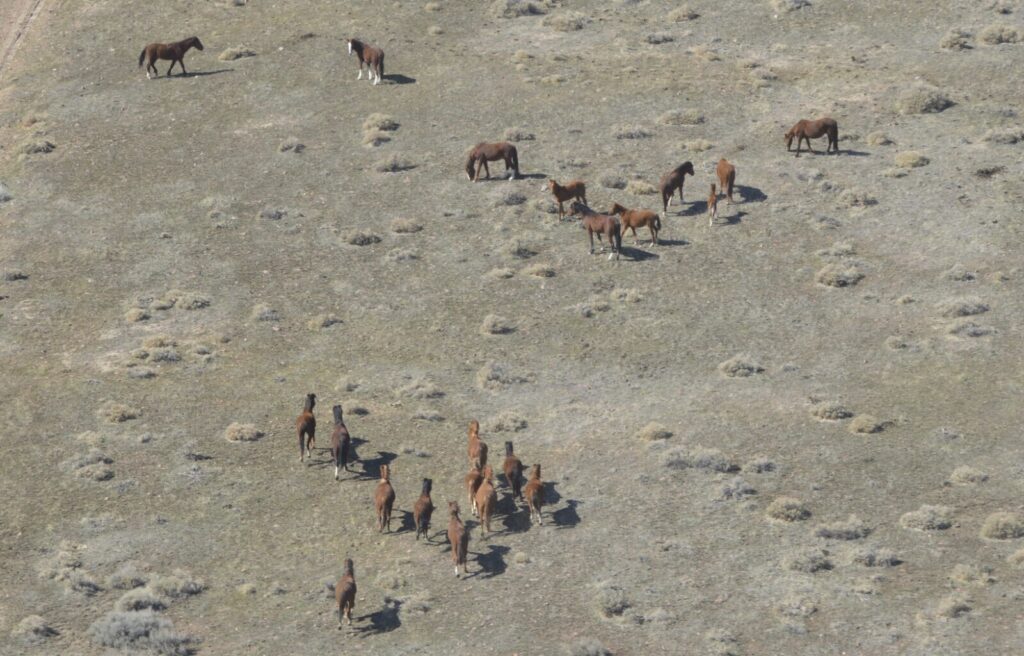
None of this is supposed to happen under the BLM‘s Comprehensive Animal Welfare Program, or CAWP, which was devised in 2015 to guide the agency in the humane handling of horses. CAWP was crafted by BLM as a trial version of the welfare standards mandated under the 1971 Wild Free-Roaming Horses and Burros Act. CAWP would not have come to pass if it weren’t for repeated lawsuits that Laura Leigh filed in federal court starting in 2010.
By 2016, the BLM had engineered an internal assessment tool that the agency said it would review annually in the run-up to an expected formalization of welfare rules. Leigh briefly volunteered for BLM during 2016 and was trained in use of the tool. However, BLM itself never actually used it, and none of the promised reviews took place. Under Biden, without any public rulemaking process and without any real testing of its efficacy in the field, the trial version of CAWP was made permanent policy.
What BLM calls a welfare policy has amounted to a series of internal standards that are unenforceable because the BLM is supposed to be self-policing. The agency, it turns out, has routinely violated its own CAWP protocols. BLM personnel use hot shot electric prods to speed up loading, an act forbidden under CAWP. Corrals have a stocking capacity limit under CAWP, yet the agency prioritizes numbers over safety, cramming as many animals into pens daily to speed the capture process. Barred under CAWP from offloading holding pens after dark, BLM does it anyway.
According to horse advocates working in the field at roundups, personnel who are supposed to be familiar with CAWP standards appear to know nothing about them. “I carry a copy of BLM’s CAWP policy with me,” Colette Kaluza, a volunteer member of Wild Horse Education’s field team, told me. “I have lost count of the number of times I’ve pointed out a policy violation while observing a roundup. The BLM person in charge will tell me that it is not in the policy and I have to pull out the sheet. ‘Would you like me to find it in the policy for you?’”
Such exchanges have become so common that Kaluza, who makes her living as a certified court reporter, likens them to a “script of a bad comedy re-run” — a script that too often ends, she claims, with insults and contempt directed at her from BLM employees. According to Leigh and Kaluza, many of the same personnel they’ve encountered who profess to know nothing about CAWP policy are part of the BLM’s own CAWP team.
(In response to a request for comment about alleged CAWP violations, a BLM spokesperson issued an emailed statement that stated “the BLM cares deeply about the wild horses and burros under our management” and “allegations of widespread violations of the Comprehensive Animal Welfare Program at gathers are unfounded. BLM continues to strive to improve handling and gather techniques to ensure all management activities are done in a safe and humane manner.”)
Following dozens of what she said were “fruitless” requests that the BLM review CAWP and create enforceable rules for handling horses, Leigh filed suit last summer in federal district court in Reno. It was, as she put it, “a last-ditch effort” to demand the honest and accountable horse welfare policy the agency had promised in 2015.
“Wild horses are scapegoated for ecological degradation of the American West with zero basis in scientific data.”
Exhibit A in the suit was the evidence that Leigh and Kaluza and others had gathered in the Antelope Complex roundup, which lasted a total of six weeks in July and August. Antelope was a prime example not only of the failure to enforce animal welfare but also of the BLM refusing to disclose data that would justify its actions. There was no census of the number of horses in the various “herd management areas” affected by the roundup. There was no rangeland health assessment to demonstrate that ecosystem degradation was solely due to wild horses, as the BLM claimed. There was no “decision of compliance” with the National Environmental Policy Act, the 1971 law that covers environmental decision-making on public lands. Under federal law, all of these — census, rangeland assessment, NEPA compliance — are necessary before BLM can begin any removal of horses. The BLM at Antelope simply went ahead and started the cull.
Consider the matter of rangeland health. It’s the consensus of scientists who study grassland ecosystems in the American West that so-called range — a reductionist term that renders complex life-worlds into a food system, range, for one species, cows — is under stress not because of a beleaguered minority of wild horses, which number in the tens of thousands, but because of millions of cows grazing on limited forage in arid lands that are less productive under the regime of climate warming.
Yet it’s the horses that get blamed by the BLM for rangeland degradation. “BLM land health assessments are rigged,” Katie Fite, an ecologist and public lands advocate with the nonprofit Wildlands Defense, told me in an email. “BLM in nearly all cases doesn’t have the data to separate wild horse versus cattle impacts.” When Public Employees for Environmental Responsibility investigated the BLM’s management of horse ranges in 2021, it charged the agency with “deliberate obfuscation of livestock eco-impacts.” Kirsten Stade, a conservation biologist who now works for the nonprofit Population Balance, partnered with a former BLM contractor to produce the analysis, which mocked the BLM’s blinkered condition of “cow blindness.” Stade had spent a decade at PEER documenting the cattle industry’s impacts on public lands. “Wild horses are scapegoated for ecological degradation of the American West with zero basis in scientific data,” she told me. “Meanwhile, humans and our livestock comprise 96% of mammalian biomass on Earth.” On the 250 million acres of public lands where cows graze, said Stade, there has been a slow-motion disaster. “Cows have wrought utter havoc on fragile riparian zones and are a major force behind species endangerment and biological impoverishment.”
When the 1971 Wild and Free-Roaming Horses and Burros Act was passed, it took 10 years to codify the law in the Code of Federal Regulations. The CFR for wild horse management, finalized in 1981, required that the BLM create science-based herd management area plans, or HMAPs. There may be no better example of the mismanagement of wild horses than the failure by our government, year after year, to abide by the law about HMAPS.
The main problem is that the provisions of HMAPs include removal of livestock if it can be shown that cow-free habitat is needed for the survival of wild horses. According to the Code of Federal Regulations, HMAPs also allow designation of critical habitat that might impede mining and livestock operations. Suffice to say, these are political nonstarters in the American West, where legislators beholden to industry routinely attack the BLM when it dares move against any profiteering interest on the public domain.
The BLM does not deny that it is required to do HMAPs. Its rationale for refusing to abide by the law is that the federal code fails to stipulate when they need to be carried out. The BLM’s preferred moment, it seems, is never.
The failure to institute horse management area plans is symptomatic of a broken culture within BLM, and culture is not easily changed. Leigh and like-minded advocates who seek a more humane paradigm thus face a Sisyphean struggle.
The lawsuit Leigh filed in federal court last summer has survived BLM’s motions to dismiss, but its prospects are uncertain, and we should remember that it needn’t have been filed at all. The Biden administration could address the wretched treatment of wild horses overnight with a stroke of Deb Haaland’s pen. But there is no sign that Biden is willing to displease the lords of the reigning cattle culture, and from Deb Haaland, there’s not a word of concern.
Your support matters…Independent journalism is under threat and overshadowed by heavily funded mainstream media.
You can help level the playing field. Become a member.
Your tax-deductible contribution keeps us digging beneath the headlines to give you thought-provoking, investigative reporting and analysis that unearths what's really happening- without compromise.
Give today to support our courageous, independent journalists.
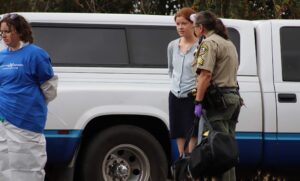
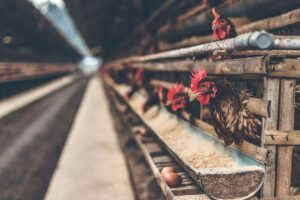
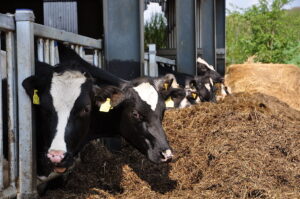
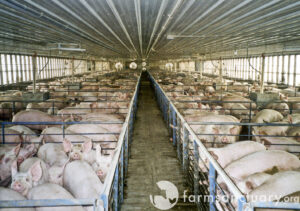


You need to be a supporter to comment.
There are currently no responses to this article.
Be the first to respond.